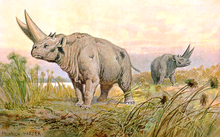| Arsinoitheriidae Temporal range:
| |
|---|---|

| |
| Skeleton of Arsinoitherium zitteli | |
| Scientific classification | |
| Domain: | Eukaryota |
| Kingdom: | Animalia |
| Phylum: | Chordata |
| Class: | Mammalia |
| Order: | †Embrithopoda |
| Family: | †Arsinoitheriidae Andrews, 1904 |
| Genera | |
| |
Arsinoitheriidae is a family of mammals belonging to the extinct order Embrithopoda.[1] Remains have been found in the Middle East, Africa, Asia and Romania. When alive, they would have borne a strong but superficial resemblance to modern rhinoceroses; however, they were not closely related to them (or any other perissodactyl), instead being more closely related to hyraxes, elephants, sirenians, and possibly desmostylians (as part of the superorder Afrotheria).
Fossil record


The last genus, Arsinoitherium, was first recovered from the Latest Eocene of the Fayum; it disappears from the fossil record altogether before the end of the Early Oligocene.
Etymology
The name honors the wife of Ptolemy II, Queen Arsinoe II of Egypt, as the first fossils of Arsinoitherium were found near the ruins of her palace.
References
- ^ Sanders, William J.; Nemec, Wojciech; Aldinucci, Mauro; Janbu, Nils E.; Ghinassi, Massimiliano (2014-07-29). "Latest evidence of Palaeoamasia (Mammalia, Embrithopoda) in Turkish Anatolia". Journal of Vertebrate Paleontology. 34 (5): 1155–1164. doi:10.1080/02724634.2014.850430. ISSN 0272-4634.


